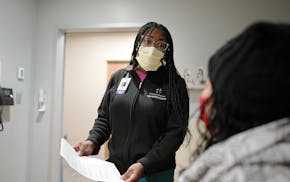Wells Fargo may be getting its mojo back, nationally and in the Twin Cities.
Minnesota is no longer the organizational heart that it was after former Norwest CEO Dick Kovacevich moved from Minneapolis to San Francisco in 1999 to become CEO of the merged bank-holding company that took the Wells Fargo name and California headquarters.
Wells Fargo, under its third CEO in five years, seems to have put behind it billions in fines and years of damage to its reputation that dimmed its star and capped growth and left Minnesota a declining regional hub.
Wells Fargo last week posted a strong $4.75 billion profit in the first quarter. And its stock price, which peaked over $50 per share in 2018 when the worst emerged about its fake-accounts scandal, has risen from under $20 per share a year ago to over $40 lately.
"I am confident that we are making progress, though it is not always in a straight line," Wells Fargo CEO Charlie Scharf told investors and analysts last week.
Scharf, 55, is a New York-based banker, a protégé of JPMorgan Chase CEO Jamie Dimon, whose single-most important hire may have been Bill Daley, vice chairman of public affairs who followed Scharf from New York-based BNY Mellon to Wells. Daley, a lawyer who also once worked for Dimon, is a former federal official and chief of staff to ex-President Barack Obama. He led Scharf's two-year quest to end Wells Fargo's legal and political problems.
"Nobody is better wired than Bill Daley," said Jim Campbell, Minnesota CEO of Norwest-Wells Fargo until his 2002 retirement. "He's in New York with Charlie. Let's face it. … Charlie has basically moved the heartbeat of the Wells Fargo enterprise to New York. That's where the major banks are headquartered."
Wells Fargo, which also has a regional hub in Charlotte, N.C., is starting to get traction on its recovery.
In Minnesota, Wells Fargo since 2018 has been led by Laurie Nordquist, who has the titles of CEO in Minnesota and president of the company's Central States region.
Wells Fargo is the second-largest bank in the state with nearly $72 billion in deposits, trailing only Minneapolis-based U.S. Bancorp.
Nordquist has a mandate to increase Wells Fargo's visibility.
"We are going to focus on affordable housing, minority small businesses specifically and small business generally, and the financial health of our customers and communities," Nordquist said in an interview.
"We will be part of significant and positive change. Our team member involvement is as important as our dollars."
Wells Fargo employment in Minnesota has declined from about 20,000 to 18,000 over the last decade amid its problems, but also reflects a streamlining in financial services focused on electronic banking and fewer branch offices.
Yet Wells Fargo also this month announced plans to redevelop its 2020-destroyed office at Lake Street and Nicollet Avenue into a $50 million-plus, 200-home housing project, including a smaller branch office at a 2.5-acre site that was mostly a parking lot and a drive-through bank.
It's a working-class neighborhood, including immigrant and minority entrepreneurs, that needs housing. And it may mark better days ahead for Wells Fargo in the Twin Cities.
Nordquist, a native of Elbow Lake, Minn., and graduate of St. Olaf College, noted that Wells Fargo opened a new regional headquarters campus on the east side of downtown in 2016 and made $7 million in "diverse community capital grants" to Twin Cities nonprofits in recent years.
Most recently, Wells Fargo said it would refund nationally the $420 million it has made for processing SBA payroll-protection loans in 2020.
The first $112 million has been disbursed, including $9 million to Twin Cities-area minority-business counselor-lenders, such as Meda, African Economic Development Solutions, Neighborhood Development Center and WomenVenture.
They take fledgling, capital-light entrepreneurs and help the most promising grow until they are bankable by traditional lenders.
Twenty years ago, Kovacevich, sensitive to public perception when he agreed to move the combined Norwest-Wells Fargo headquarters to San Francisco, essentially gave Campbell about $280 million to buy, renovate and expand the abandoned Honeywell campus into a Wells Fargo regional mortgage campus. Local employment skyrocketed.
Campbell, his successor and Kovacevich proved, at least for a decade, that you could lose your national headquarters to a merger, but still grow locally.
A lot of Twin Citians thought Wells Fargo was still based here, which is just what Campbell and his colleagues hoped.
"Kovacevich left me with a lot of money and flexibility," Campbell said. "I got everything I wanted. The Honeywell campus was a fortuitous thing. My sense is that Wells Fargo, still a heck of a franchise, will ride through this period. But Minneapolis-St. Paul will never be, within Wells Fargo, what it was. They probably say the same thing in Charlotte."

St. Anthony: 'Patient' investing paying off for St. Paul's Hill Capital

Jennifer Smith, leader of Burnsville's Innovative Office Solutions, has died

St. Anthony: Medical professions in Minnesota need more people of color in their ranks



